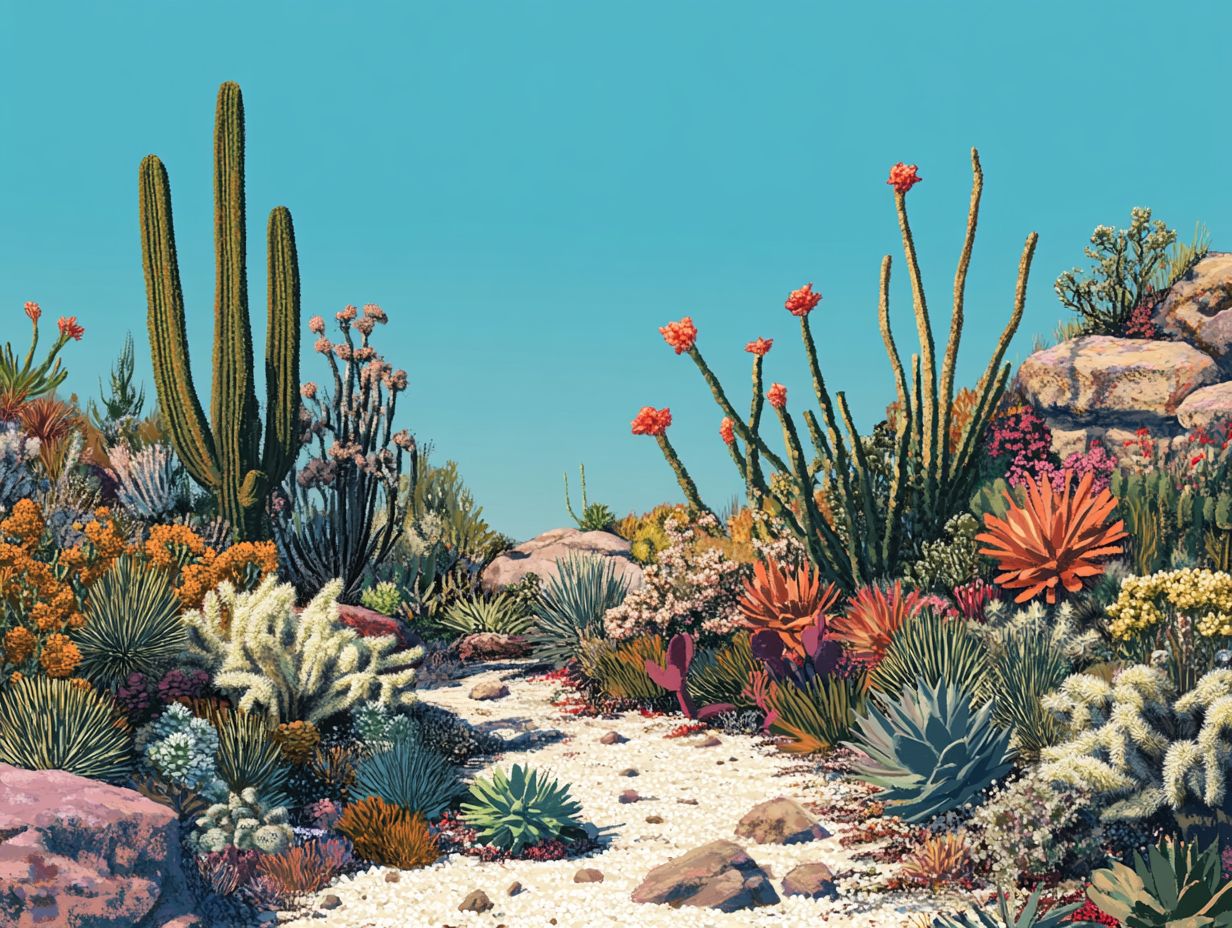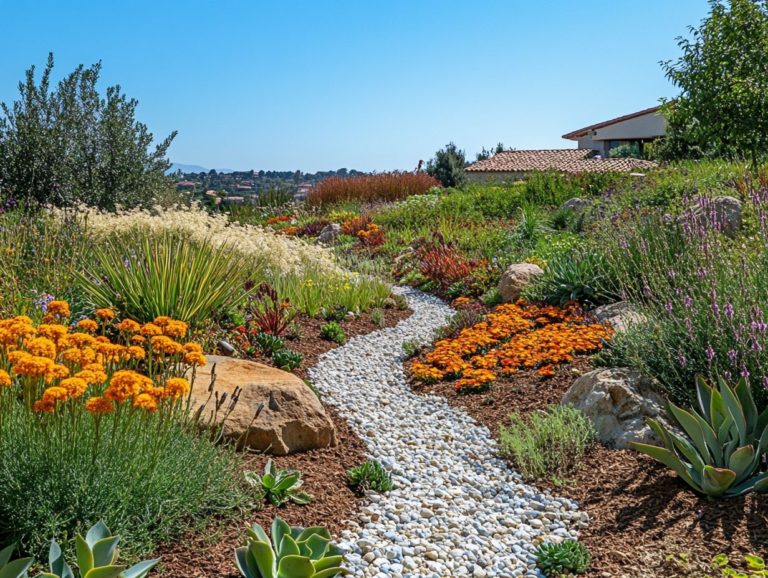The Aesthetics of Drought-Tolerant Landscapes
Drought-tolerant landscapes are not merely a trend; they embody a savvy solution for modern gardening, especially in a time characterized by climate change and water scarcity.
This article delves into the essence of drought-tolerant landscapes, illuminating their environmental and economic advantages while providing you with practical design tips.
From choosing the right plants to nurturing a vibrant, sustainable garden, you ll learn how to craft an outdoor space that flourishes even in dry conditions.
Embrace a landscape that harmonizes beauty with sustainability!
Contents
- Key Takeaways:
- Understanding Drought-Tolerant Landscapes
- Benefits of Drought-Tolerant Landscapes
- Designing a Drought-Tolerant Landscape
- Choosing Drought-Tolerant Plants
- Maintaining a Drought-Tolerant Landscape
- Creating a Beautiful and Sustainable Landscape
- Frequently Asked Questions
- What are drought-tolerant landscapes?
- Why are drought-tolerant landscapes becoming popular?
- How can I incorporate drought-tolerant plants into my landscape?
- Do drought-tolerant landscapes have to look barren and unappealing?
- Can drought-tolerant landscapes only be used in areas with frequent droughts?
- What are the benefits of having a drought-tolerant landscape?
Key Takeaways:

- Drought-tolerant landscapes are designed to use minimal water while still providing beauty and functionality, making them an environmentally and economically beneficial option.
- When designing a drought-tolerant landscape, consider key principles such as using native plants and efficient watering techniques to create a sustainable and beautiful outdoor space.
- Incorporating aesthetics into drought-tolerant design can be achieved by choosing plants with interesting textures and colors, incorporating hardscape elements, and paying attention to the overall layout and balance of the landscape.
Understanding Drought-Tolerant Landscapes
Understanding drought-tolerant landscapes is vital for homeowners eager to cultivate an environmentally friendly garden that demands minimal maintenance and conserves water. Exploring the role of drought-resistant plants in landscaping can provide valuable insights for creating such spaces.
These landscapes use specific techniques to enhance beauty while transforming your landscape for drought. They focus on resilient plants that thrive in dry conditions.
By choosing drought-tolerant landscaping, you not only support local ecosystems but also minimize the need for elaborate irrigation systems, making it a sustainable choice, especially in water-conscious regions like California.
What are Drought-Tolerant Landscapes?
Drought-tolerant landscapes are crafted with meticulous care to minimize water usage while still presenting an appealing aesthetic and supporting the local ecosystem. Understanding the benefits of drought-resistant landscaping can further enhance your gardening choices.
By incorporating water-wise plants, such as succulents and perennials, and innovative hardscape elements, these landscapes become a harmonious blend of beauty and sustainability.
Efficient irrigation systems, like drip irrigation, take water conservation a step further by delivering moisture directly to the roots where it’s needed most.
Hardscaping materials think gravel, stone, and permeable pavers not only limit the necessity for traditional lawns but also promote natural drainage and prevent runoff.
By emphasizing sustainable gardening practices, these designs foster biodiversity, attract beneficial wildlife, and contribute to a healthier planet for all.
Benefits of Drought-Tolerant Landscapes
Discover the amazing benefits of drought-tolerant landscapes that can elevate your property while championing the environment.
By embracing these designs, you conserve water, lower maintenance costs, and bolster resilience against the challenges of climate change.
This makes them not only a wise economic choice but also an ecologically responsible decision for discerning homeowners like yourself.
Environmental and Economic Benefits
The environmental and economic benefits of drought-tolerant landscapes are truly remarkable. They enhance your garden’s beauty while contributing to vital water conservation efforts and reducing maintenance needs, as highlighted in the environmental impact of drought-resistant gardening.
For instance, you might be surprised to learn that homeowners in California have reported saving up to 50% on their water bills after making the switch to drought-resistant plants. This gardening method, which uses native, low-water varieties, not only significantly cuts down on water usage but also provides a sanctuary for local wildlife, creating habitats for birds and beneficial insects.
For those in Southern California, a stunning example is a community initiative that highlighted a neighborhood that collectively transformed traditional lawns into drought-tolerant gardens, resulting in a staggering reduction of 30 million gallons in water consumption each year.
This shift not only alleviates pressure on local water supplies but also fosters a greener ecosystem, proving that embracing sustainable gardening practices can lead to both environmental enhancement and economic savings.
Start your journey toward a beautiful, low-water garden today!
Designing a Drought-Tolerant Landscape

Designing a drought-tolerant landscape requires a good understanding of essential principles and elements that blend efficiency with beauty. Incorporating water features in drought-tolerant landscapes can transform your outdoor space into a stunning oasis while respecting the environment.
Key Principles and Considerations
Key principles in designing a drought-tolerant landscape focus on smart water use, soil conservation, and carefully selecting plants that thrive in your local conditions.
To achieve these goals, focus on soil preparation methods that enhance moisture retention. Incorporate organic matter, like compost, to enrich the soil structure, improve drainage, and boost nutrient availability.
Choose native and adaptive plants that have evolved to withstand dry periods. This promotes resilience in your landscape and supports local ecosystems.
Use mulch to retain soil moisture and prevent erosion, reducing your need for extensive watering. Implement innovative resource management techniques, like rainwater harvesting systems or drip irrigation, to optimize water usage, minimize waste, and create a sustainable, visually stunning landscape.
Choosing Drought-Tolerant Plants
Selecting the right drought-tolerant plants is essential for cultivating a resilient garden. You can enjoy both aesthetic appeal and ecological advantages with minimal water.
Explore a diverse array of options, from perennials to groundcovers, all designed to flourish in arid conditions. These thoughtful choices enhance the beauty of your space and support a sustainable environment.
Types of Plants and Their Characteristics
Discover a variety of drought-tolerant plants, including perennials, succulents, and various types of grasses. Each has distinct characteristics that allow them to thrive in low-water conditions.
These plants fit well in various landscape designs, from arid gardens to sleek, modern patios. Perennials like lavender and sage add vibrant color and delightful fragrances that elevate your outdoor space.
Succulents, such as agave and jade plants, with their plump leaves, provide striking visual interest and are incredibly low-maintenance.
Ornamental grasses, including blue fescue and feather reed grass, introduce texture and movement to your garden while making efficient use of limited water resources.
Incorporate these varieties to craft a visually stunning and eco-friendly landscape that thrives in tough climates.
Maintaining a Drought-Tolerant Landscape
To achieve a drought-tolerant landscape, implement efficient watering techniques and care strategies that help your plants flourish and conserve valuable moisture.
Efficient Watering and Care Techniques

Efficient watering and care techniques are crucial for the success of drought-tolerant landscapes. Use innovative irrigation systems and methods to conserve moisture and promote healthy plant growth.
Embrace these sustainable gardening practices to significantly reduce water usage without sacrificing the vibrancy and resilience of your outdoor spaces. One effective approach is to use drip irrigation systems, which deliver water directly to plant roots, minimizing evaporation.
Mulching is important; it retains soil moisture and regulates temperature, helping your plants withstand dry spells.
Incorporating rainwater harvesting adds another layer of efficiency. Collect and utilize natural precipitation to create an environment where drought-tolerant plants not only survive but thrive, leading to a more sustainable and eco-friendly landscape.
Creating a Beautiful and Sustainable Landscape
Crafting a beautiful and sustainable landscape requires meticulous planning and the thoughtful integration of aesthetic elements. By harmonizing visual appeal with environmental responsibility, you can create a space that captivates the eye and nurtures the ecosystem.
Tips for Incorporating Aesthetics into Drought-Tolerant Design
Incorporating aesthetics into your drought-tolerant design is about careful choices that blend colors, textures, and structures. This creates a visually captivating landscape while promoting water conservation, highlighting the future of drought-resistant landscaping.
By selecting a diverse palette of drought-resistant plants, you can achieve dynamic contrasts that draw the eye. Imagine pairing vibrant succulents with smooth gravel pathways; this not only enhances visual interest but also elevates functionality.
Think about using decorative boulders or artistic outdoor sculptures as focal points. These additions can greatly enhance your space’s charm. It s wise to consider seasonal interest. Opt for species that offer blooms or changing foliage throughout the year, keeping your garden lively and engaging.
Don t overlook the power of mulch; it conserves moisture and enhances the look of garden beds, solidifying the aesthetic value of your landscape.
Frequently Asked Questions
What are drought-tolerant landscapes?
Drought-tolerant landscapes are outdoor spaces designed to thrive in dry conditions through smart design and care. Utilizing techniques like Xeriscaping, a method that focuses on water-efficient landscaping, can improve your garden s water use.
Why are drought-tolerant landscapes becoming popular?

Drought-tolerant landscapes are trending! They save water, cut maintenance costs, and add unique beauty to your property. Institutions like UC Berkeley and the California Native Plant Society advocate for these sustainable practices, including using gravel in drought-friendly designs.
How can I incorporate drought-tolerant plants into my landscape?
Here are some ways to include drought-tolerant plants:
- Use native plants.
- Choose succulents and cacti like the Golden Barrel Cactus and Agave attenuata.
- Install drip irrigation systems for efficient watering.
Do drought-tolerant landscapes have to look barren and unappealing?
No! Drought-tolerant landscapes can be stunning and vibrant. With thoughtful planning and design, these spaces can showcase a variety of colors and textures, reflecting the impact of drought on landscaping choices.
Experts like Charlene Brum and Taryn Tree can help you create a beautiful landscape that stands out.
Can drought-tolerant landscapes only be used in areas with frequent droughts?
No, you can enjoy drought-tolerant landscapes in any climate. They thrive in dry conditions and can also flourish in regions with more rainfall, like California.
What are the benefits of having a drought-tolerant landscape?
These landscapes conserve water and lower maintenance costs. They also attract wildlife, improve air quality, and increase your property’s value.
Partner with experts like the American Society of Landscape Architects for innovative tips that can transform your space!






